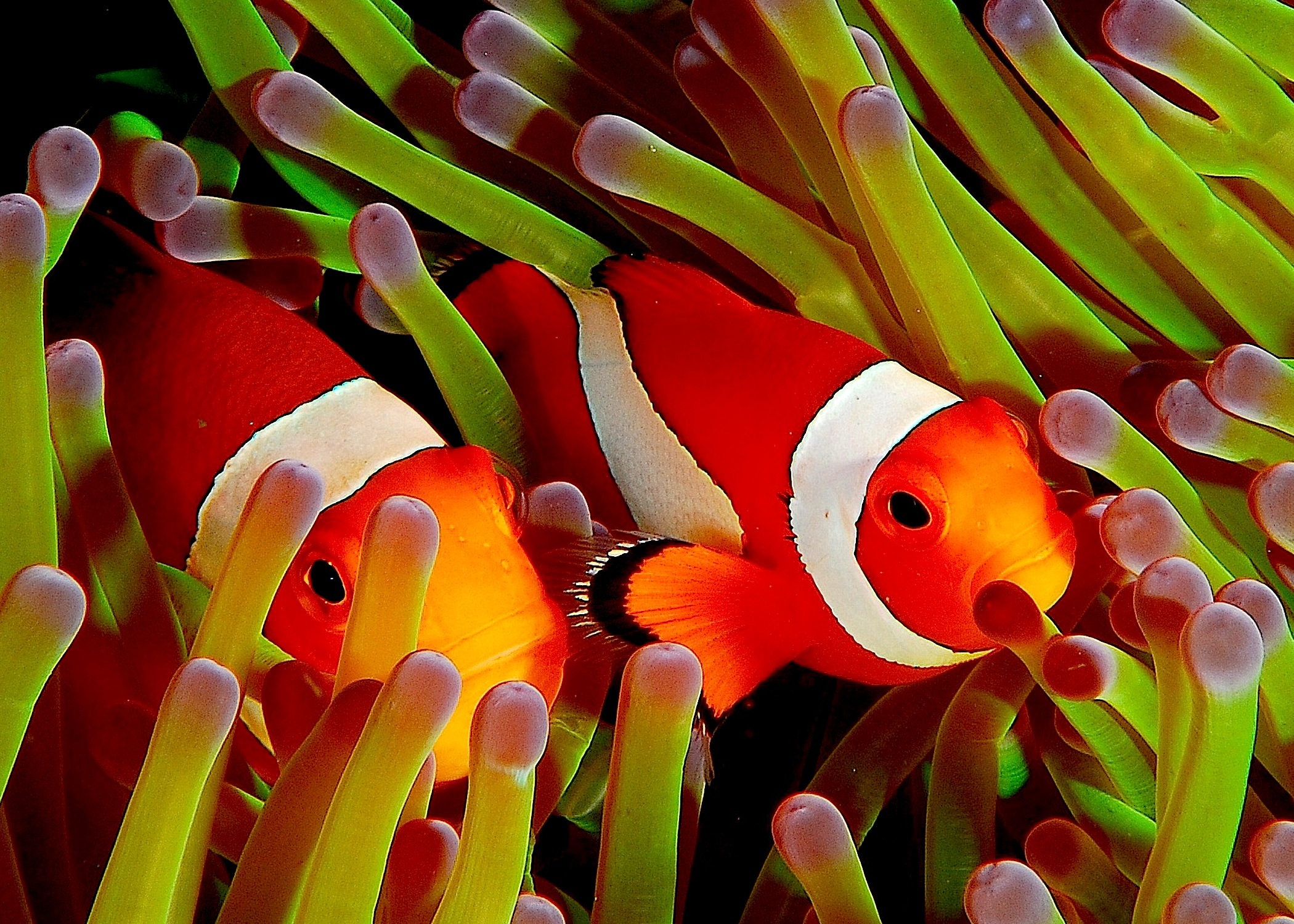
Common clownfish guarding their sea anemone home – source: Wikipedia (click on the image for full attribution)
story by Helen Hill

This month we feature work by researchers affiliated with King Abdullah University of Science and Technology (KAUST) Gerrit Nanninga, Pablo Saenz-Aguedo (now at the Universidad Austral de Chile), Peng Zhan, Ibrahim Hoteit, and Michael Berumen who have been using MITgcm as the basis for a biophysical dispersal model they developed to examine the larval dispersal for an anemone fish, Amphiprion bicinctus, at a solitary coral reef in the central Red Sea.
A changing marine environment stresses not only the corals that form reefs, but the marine invertebrates and fishes that make coral reefs their home.
A complicating factor in human efforts seeking to counteract these effects through e.g. fisheries management, designation of marine reserves, and control of invasive species is an understanding of larval dispersal.
It used to be assumed that marine larvae ride passively on the prevailing circulation. Over the past 15 years however, studies of larval dispersal in coral reef fishes have generated accumulating evidence that some larvae are able to purposefully return to their hatch site – a process termed self-recruitment.
In their study Nanninga et al set up a nested MITgcm configuration with a small-domain model (horizontal resolution 250m) ~ 0.7 degrees x 0.7 degrees, nested within zonal/meridional current velocity, temperature and salinity on north, west, and south boundaries from a coarser model (horizontal resolution 4km) configured for the entire Red Sea basin.
To find out more about this work contact Gerrit.
This Month’s Featured Publication
- Nanninga, G.B., P. Saenz-Aguedo, P. Zhan, I. Hoteit, M.L. Berumen (2015), Not finding Nemo: limited reef-scale retention in a coral reef fish, Coral Reefs, doi: 10.1007/s00338-015-1266-2
Other New Publications this Month
J.C.B. da Silva, M.C. Buijsman, and J.M. Magalhaes (2015), Internal waves on the upstream side of a large sill of the Mascarene Ridge: a comprehensive view of their generation mechanisms and evolution, Deep Sea Research Part I: Oceanographic Research Papers, Volume 99, May 2015, Pages 87–104, doi: 10.1016/j.dsr.2015.01.002
Ichiro Fukumori, Ou Wang, William Llovel, Ian Fenty, and Gael Forget (2015), A Near-Uniform Fluctuation of Ocean Bottom Pressure and Sea Level across the Deep Ocean Basins of the Arctic Ocean and the Nordic Seas, Progress in Oceanography (in press), doi: 10.1016/j.pocean.2015.01.013
J. Hauck and C. Völker (2015), Rising atmospheric CO2 leads to large impact of biology on Southern Ocean CO2 uptake via changes of the Revelle factor, Geophysical Research Letters (accepted article), doi: 10.1002/2015GL063070
Andrew McC. Hogg, Michael P. Meredith, Don P. Chambers, E. Povl Abrahamsen, Chris W. Hughes, and Adele K. Morrison (2015), Recent trends in the Southern Ocean eddy field, Journal of Geophysical Research Oceans, Journal of Geophysical Research: Oceans, Volume 120, Issue 1, pages 257–267, doi: 10.1002/2014JC010470
Kataria, T. (2014) Atmospheric Circulation of Hot Jupiters and Super Earths, Doctoral Dissertation, University of Arizona,
Shane R. Keating and K. Shafer Smith (2015), Upper ocean flow statistics estimated from superresolved sea-surface temperature images (2015), Journal of Geophysical Research Oceans (early view), doi: 10.1002/2014JC010357Paleoceanography (Accepted article), doi: 10.1002/2014PA002675
Mackay, Neill (2014), A study of diapycnal mixing in the Southern Ocean using a tracer release experiment and numerical models, Doctoral Dissertation University of East Anglia, UK link
D. R. Munday, H. L. Johnson, and D. P. Marshall (2015), The role of ocean gateways in the dynamics and sensitivity to wind stress of the early Antarctic Circumpolar Current (2015), Paleoceanography (Accepted article), doi: 10.1002/2014PA002675
Louis-Philippe Nadeau and Raffaele Ferrari (2015), The role of closed gyres in setting the zonal transport of the Antarctic Circumpolar Current, Journal of Physical Oceanography (e-View), doi: 10.1175/JPO-D-14-0173.1
Nanninga, G.B., P. Saenz-Aguedo, P. Zhan, I. Hoteit, M.L. Berumen (2015), Not finding Nemo: limited reef-scale retention in a coral reef fish, Coral Reefs, doi: 10.1007/s00338-015-1266-2
C. G. Piecuch and R. M. Ponte (2015), A wind-driven nonseasonal barotropic fluctuation of the Canadian
inland seas, Ocean Sci., 11, 175–185, doi: 10.5194/os-11-175-2015
Brian Rose (2015), Stable “Waterbelt” climates controlled by tropical ocean heat transport: A nonlinear coupled climate mechanism of relevance to Snowball Earth, Journal of Geophysical Research Atmospheres (early view), doi: 10.1002/2014JD022659
Isabella Rosso, Andrew McC. Hogg, Andrew E. Kiss and Bishakhdatta Gayen (2015) Topographic influence on submesoscale dynamics in the Southern Ocean, Geophysical Research Letters (early view), doi: 10.1002/2014GL062720
Kristen M. Thyng and Robert D. Hetland (2015), TracPy: Wrapping the Fortran Lagrangian trajectory model TRACMASS, PROC. OF THE 13th PYTHON IN SCIENCE CONF. (SCIPY 2014) link (includes VIDEO)
Qinghua Yang, Svetlana N. Losa, Martin Losch, Thomas Jung and Lars Nerger (2015), The role of atmospheric uncertainty in Arctic summer sea ice data assimilation and prediction, Quarterly Journal of the Royal Meteorological Society (accepted article), doi: 10.1002/qj.2523
Jonathan Whitefield, Peter Winsor, James McClelland, and Dimitris Menemenlis (2015), A new river discharge and river temperature climatology data set for the pan-Arctic region, Ocean Modelling (in press), doi: 10.1016/j.ocemod.2014.12.012
Do you have news about research using MITgcm? We are looking for contributions to these pages. If you have an interesting MITgcm project (ocean, atmosphere, sea-ice, physics, biology or otherwise) that you want to tell people about, get in touch. To make a post, contact Helen

